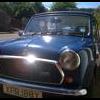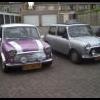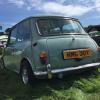So a bit more progress yesterday, managed 3 - 4 hours and got cracking on the chambers.
First here's the setup, hoover pipe clamped in place to extract metal filings, and head clamped down to prevent movement. The biggest issue is visibility, I had a light mounted overhead but it needs to be lower and more powerful.

Although I have not widened the valve throats yet, or cut the valve seats yet, to prevent any damage and to help keep the roof height reference, I inserted some cut down valves.

The chosen mount point for this job was a conical, flat based aluminium oxide.

With this tool in the chuck, I started on the chamber roof, in the area to the front and back of the valves. valves.

Next, around the valves and down to the reference mark that I had cut with the milling attachment in the lathe (oh how I wish I had a milling machine).

At this point I stopped to check the depth of cut with a vernier depth gauge and then marked any high particular spots with a sharpie.


Then a bit more grinding in the high areas.

And here's a two of the four chambers after this stage of grinding

Now it was time to tackle the chamber walls again, before doing this I had to put the used head gasket in place and mark the gasket profile. Next I used the chamber template and marked the chamber profile again and them highlighted the areas of the wall that needed grinding.
What is not seen in the pic is that I made a wall profile with a piece of scrap aluminium, this is to get the wall angle to around 7 degrees.

Note that the gasket is held in place with 3D printed plugs.


Marking the gasket profile ensures that as long as the chamber profile edge is inside the sharpie and will not compromise the head gasket when fitted (none of this I would have known without advice from the experts out there).
I also used a carbide burr first to remove the largest areas of material.
Next up I used an ATA band with some a coarse paper drum (50 or 60 grit I think) and then a slightly finer one and cleaned up the grinding marks.

These were the results


I think I sorted out the indentations in the chamber above, top left of the exhaust and inlet, but if not I must have missed them and they'll need sorting.



And after a little more cleaning up and a spray of WD40.


Yes there are some imperfections in the ports, but this is a first go (the WD 40 pooling make it look a bit worse). I may do a bit more cleaning up, but I'd be happy to put this in my engine and see how it goes 
Edited by JonnyAlpha, 13 March 2022 - 07:17 PM.























































